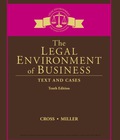
EBK THE LEGAL ENVIRONMENT OF BUSINESS:
10th Edition
ISBN: 9781337516051
Author: Miller
Publisher: YUZU
expand_more
expand_more
format_list_bulleted
Question
Chapter 25, Problem 3CT
Summary Introduction
Case summary:The Environmental Protection Agency (EPA) developed two rules namely, Phase I and Phase II. Phase I rule provides for the restriction of water inflow to a level equivalent to a level achieved through a closed-cycle recirculating cooling system. Phase II rule applies "national performance standards" to over 500 existing plants. They pleaded that converting these plants to closed-cycle systems will bear more costs and fewer benefits. Various environment organizations were aggrieved by this decision and they challenged phase II rule in US court.
To find: Necessity to draw a line on the nation’s border while analyzing the actions affecting the environment.
Expert Solution & Answer
Want to see the full answer?
Check out a sample textbook solution
Students have asked these similar questions
Can you solve this general accounting question with the appropriate accounting analysis techniques?
Answer? ? Financial accounting
I am looking for the correct answer to this general accounting problem using valid accounting standards.
Chapter 25 Solutions
EBK THE LEGAL ENVIRONMENT OF BUSINESS:
Knowledge Booster
Similar questions
- What are the estimated cash receipts from accounts receivable?arrow_forwardLawrence Industries produces kitchen knives. The selling price is $25 per unit, and the variable costs are $10 per knife. Fixed costs per month are $6,000. If Lawrence Industries sells 30 more units beyond breakeven, how much does profit increase as a result?arrow_forwardhow utillity relate to microeconomics ?arrow_forward
arrow_back_ios
SEE MORE QUESTIONS
arrow_forward_ios
Recommended textbooks for you
 Foundations of Business (MindTap Course List)MarketingISBN:9781337386920Author:William M. Pride, Robert J. Hughes, Jack R. KapoorPublisher:Cengage Learning
Foundations of Business (MindTap Course List)MarketingISBN:9781337386920Author:William M. Pride, Robert J. Hughes, Jack R. KapoorPublisher:Cengage Learning Foundations of Business - Standalone book (MindTa...MarketingISBN:9781285193946Author:William M. Pride, Robert J. Hughes, Jack R. KapoorPublisher:Cengage Learning
Foundations of Business - Standalone book (MindTa...MarketingISBN:9781285193946Author:William M. Pride, Robert J. Hughes, Jack R. KapoorPublisher:Cengage Learning

Foundations of Business (MindTap Course List)
Marketing
ISBN:9781337386920
Author:William M. Pride, Robert J. Hughes, Jack R. Kapoor
Publisher:Cengage Learning


Foundations of Business - Standalone book (MindTa...
Marketing
ISBN:9781285193946
Author:William M. Pride, Robert J. Hughes, Jack R. Kapoor
Publisher:Cengage Learning